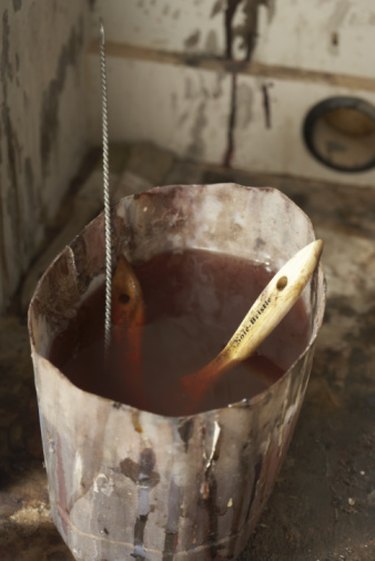Things You'll Need
Paint thinner
Mineral spirits
Turpentine
Kerosene

Paint thinner can be used as a general term to categorize any solvent that either thins oil-based paint prior to painting, or cleans or removes oil-based paint after use. The term paint thinner can be synonymous with mineral spirits in commercial terms, according to TheFreeDictionary.com. Turpentine is an oily extract of pine resin, and kerosene is derived from crude petroleum. Though turpentine and kerosene can be used as paint thinners as well, usually these products are labeled with their true names.
Step 1
Determine why you need the solvent before you decide which product will work best. Paint thinner, often marketed as synonymous with mineral spirits or white spirits, generally can be used to thin oil-based paint, stain and varnish, but some paint thinner labels warm against thinning lacquer or shellac. Turpentine is considered less toxic and also to have more solvency than petroleum-based paint thinners, including the ability to remove hardened paint from paint brushes as opposed to just fresh paint, as mineral spirits will do, says The New York Times. Like mineral spirits, many turpentine labels warn against using to thin lacquer or shellac. Kerosene is a less harsh, lighter oil that can thin paint. It is marketed predominantly to fuel engines, furnaces and stoves.
Video of the Day
Step 2
Learn the synonyms for each type of paint solvent. Paint thinner and mineral spirits often are very similar in chemical makeup. Most paint thinners are referred to as white spirit solvents, which are the same as mineral spirits. Turpentine is also called gum spirits or turps. Kerosene is also called coal oil, kerosine, furnace oil No. 1 or range oil, says the U.S. Agency for Toxic Substances and Disease Registry.
Step 3
Decide how much of an odor you can tolerate. While paint thinner, mineral spirits, white spirits, turpentine and kerosene all produce strong odors, turpentine often is considered to give off the most powerful smell. Odorless versions of mineral spirits and kerosene are available.
Step 4
Decide how much you want to spend. Kerosene and paint thinner/mineral spirits cost roughly about $10 per gallon, while turpentine can cost from $40 per gallon, up to $80 or more for the specialty steam-distilled type. Odorless mineral spirits cost about 50 percent more, and odorless kerosene is about the same price as the original.
Warning
Read all directions on solvent labels before use. Use all necessary protective gear when using solvents. Always use solvents in a well ventilated area. Do not use solvents near open flames.
Video of the Day
- Centers for Disease Control and Prevention: NIOSH Pocket Guide to Hazardous Chemicals: Turpentine
- Centers for Disease Control and Prevention: NIOSH Pocket Guide to Hazardous Chemicals: Kerosene
- FAO Corporate Document Repository: Chapter 8, Turpentine from Pine Resin
- The Free Dictionary: Paint Thinner
- WMBarr.com: Klean Strip Paint Thinner
- Integrated Publishing: Basic Military Requirements
- "New York Times"; How to Use and Apply Solvents; October 1996
- TechLib.com: Paint and Adhesive Removal